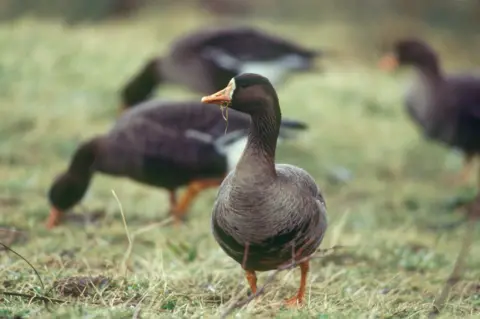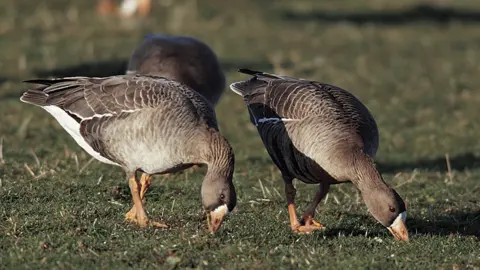RSPB Ynyshir wild goose tagging reveals 'vital data'
 Andy Hay (rspb-images.com)
Andy Hay (rspb-images.com)Electronic tags fitted to one of Europe's rarest birds have revealed "vital data" that could help safeguard the species, researchers have said.
The RSPB estimates the population of Greenland white-fronted geese at its Ynyshir reserve near Machynlleth, Powys, has declined by 83% since 1990.
Very little is known about the birds.
But a study, funded by the Welsh Government, has provided new insights described as "a glimmer of hope".
The Ynyshir reserve is the only spot in Wales where the elusive geese spend the winter.
The aim was to understand more about their movements in the Dyfi Estuary and monitor their migration back to breeding grounds in Greenland in the spring.
The highest count that winter had been 22 birds, compared with upwards of 150 regularly wintering at Ynyshir in the 1980s and 1990s.
The global population of Greenland white-fronted geese is estimated to be 18,879 - the lowest recorded since spring 1985 - and a marked decline on the last estimate of 20,797 in spring 2014.
One year on, and 25 have returned to Ynyshir this winter, with researchers involved in the £24,000 study claiming they have been rewarded with a wealth of data.
The electronic tags have allowed the team to monitor their movements in real time.
Carol Fielding, team leader for Natural Resources Wales in the Dyfi Estuary, said it meant the environment watchdog now knew for the first time "which areas the birds are using, where they're feeding, where they're roosting".
"All this data will now be really important for us in the future because we'll be able to manage the estuary for them so that hopefully we can send them back to Greenland in really good condition to breed," she said.
Ian Danby, head of biodiversity for the British Association of Shooting and Conservation, another partner in the study, said new management procedures being put in place as a result of the data were already having an impact.
"One of the surprises has been how faithful the birds have been to certain fields," he said.
"Now, we're sampling within fields and between fields, to find out how tall the vegetation is, what it's comprised of, so we can really hone in and replicate that for them.
"Ideally we want them fat as butter before they travel back up to Greenland."
'Really exciting'
Tom Kistruck, from the RSPB, explained only a select few birds tended to be in a good enough condition to attempt to breed, which scientists believe is partly to blame for their decline.
Of the two females tagged last year, one was recorded as having sat on a nest in Greenland for roughly four weeks, and was located in Iceland towards the end of the summer with four goslings.
But the second goose did not breed.
Mr Kistruck added the data also suggested climate change could be playing a part in the geese's struggle.
He said: "We know the areas they're breeding in are freezing up a bit later than they would normally - and therefore they're not able to get breeding as quickly as they would like to."
Other findings from the research also showed the Ynyshir birds had been mixing with wintering populations from Scotland and Ireland for the first time.
 Andy Hay (rspb-images.com)
Andy Hay (rspb-images.com)Groups of geese from Wales and Scotland came together on the south coast of Iceland, setting up camp just fields apart as they rested en route to Greenland.
One of the tagged geese, having spent part of the winter in Wales, flew on to Wexford and is currently on the island of Coll in Scotland.
Partners in the research also include the Wildfowl and Wetlands Trust, Welsh Ornithological Society and Dyfi, Mawddach and Dysynni Wildfowlers Association.
They believe there is more left to discover over the coming months.
"It's really exciting," Ms Fielding concluded.
"The numbers of geese returning to Wales have gone up this year for the first time in a number of years. We've got this glimmer of hope now."
